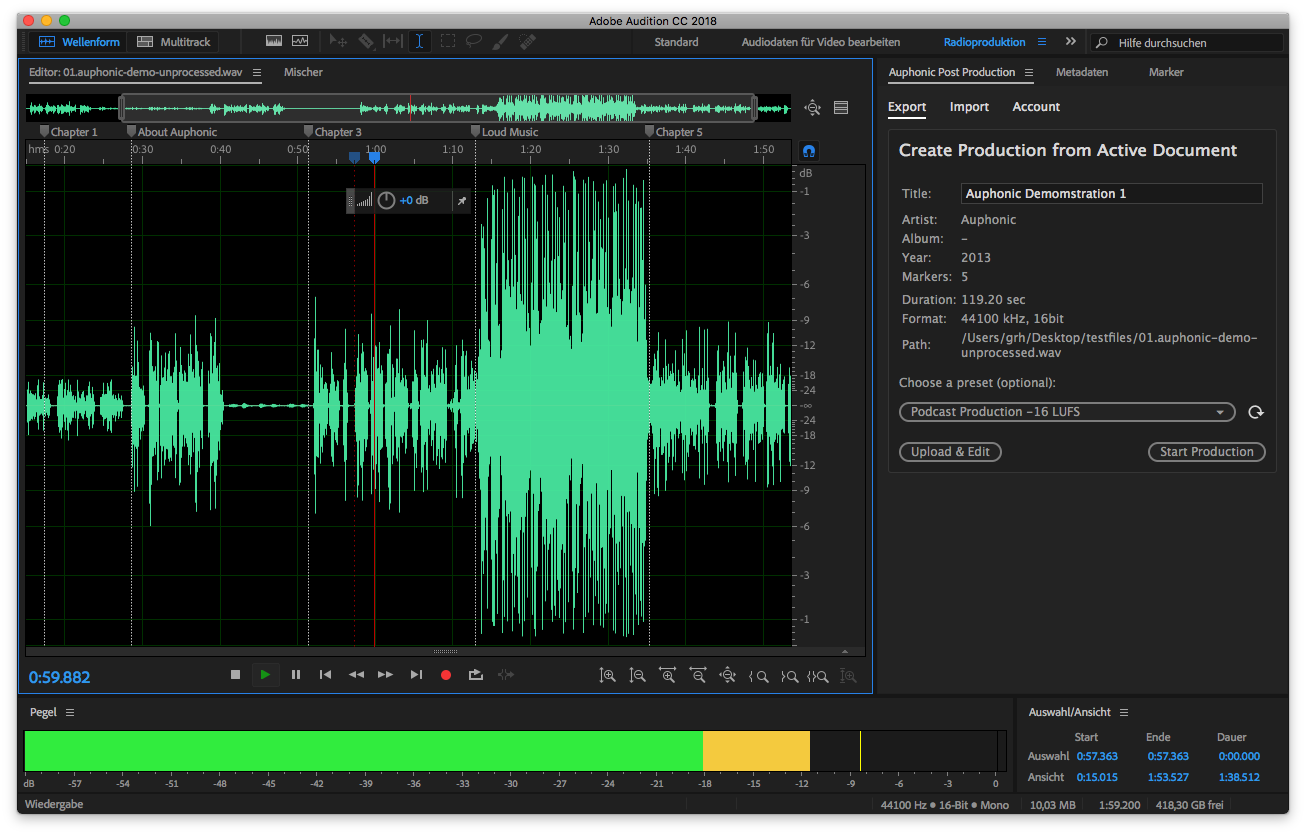Cover image via
- Premiere Pro And Audition
- Adobe Audition Vs Premiere Pro
- Adobe Audition Vs Premiere Pro
- Adobe Audition Premiere Pro
When you’re editing external audio files, protecting the original recording is essential. Follow these steps to safeguard your audio while you work.
Top image via Shutterstock.
Along with tools for color, audio, and graphics, Premiere Pro works seamlessly with other apps and services, including After Effects, Adobe Audition, and Adobe Stock. Open a Motion Graphics template from After Effects or download one from Adobe Stock and customize it — all without leaving the app. Hi I've just updated my CC2021 and Audition and premiere DOESN'T work anymore. Especially in Premiere pro I right click on the music track on the timeline but the function EDIT CLIP IN AUDITION DOESN'T WORK. Both with wav and mp3. Maybe is the audio format?
Good field recording engineers will often do things like leave plenty of headroom to avoid peaking out a recording if someone suddenly laughs, screams, or makes a loud noise. Betasat usb devices driver download for windows. This is an excellent way to preserve the quality of the recording, but it can make it difficult for you to make creative editing choices if you are constantly riding your computer’s volume just to understand the content. Further, with the wrong approach, you can accidentally apply permanent effects to your audio. Here’s one way to preserve the original recordings while you edit.
Image via Shutterstock.
Before you begin editing, create one folder with your original audio files and a second one called “Edited Audio.” Asix multifunction devices driver download for windows. Paste copies of the original audio files in the “Edited Audio” folder. You now have two copies of your project’s external audio. Open all of your “Edited Audio” in Adobe Audition and make any necessary edits.
It’s very important that you do not change the duration of any of your clips in Audition. The copies must match the originals in duration, or they will fall out of sync.
If you recorded something like an interview in a very controlled environment, this would be an excellent time to create a batch processing command if you are in a hurry and just need functional audio for easier editing. Because you still have your originals, it doesn’t matter if your first attempts are slightly off the mark.
Once you have completed your edits, you can save all of the files and close your audio editor. Notice in the picture below that metadata sidecars appear after you perform your edits; this is normal.
Remember that the audio files in Adobe Premiere Pro are still the unedited original files. In order to substitute them with your newly edited files, you first need to take the originals offline. Highlight all of the audio files listed, right-click, and select “Make Offline.”
Premiere Pro And Audition

A dialogue box will ask if you want to keep the media on disk or if you should delete the files once they are offline. Adobe Premiere defaults to keeping them on disk. Make sure you select “Media Files Remain on Disk,” or you will delete your original audio files!
Relink your media to the newly edited files in your “Edited Files” folder by selecting all of the offline audio files you just disconnected, right-clicking, and selecting “Link Media.”
A new dialogue box will allow you to browse to the new files’ location. Click the “Locate” button and navigate to the “Edited Audio” folder containing your newly edited audio files. You can verify that you’re using the correct path by looking at the area near the top of the dialogue box for “Last Path” and “Path” indications. “Path” will show the new location you’ve just specified. Once you can see everything is correct, then click the “Locate” button.
In this instance, to solve the problem of audio that is too quiet due to the headroom the engineer left while recording, I increased the volume of each clip in Audition, and I can clearly see that the waveforms in my timeline are now larger. To further verify the audio’s functionality, right click on one of your audio files and select “Reveal in Finder.” If all has gone well, then a Finder window will open showing the files in the “Edited Audio” folder.
It is important to note that using the “Edit Clip in Adobe Audition” command is also a way to edit audio without altering your originals. However, there are several scenarios during which that command can take quite a bit of time if you have already started editing and don’t want to individually affect each clip. Although you can highlight individual audio clips in the project folder inside Adobe Premiere, you currently cannot send a batch of clips to Audition, which is very time-consuming if you need to quickly adjust several files. I typically find that this scenario arises when there are several takes during an interview or a segment of dialogue — or if there are several different audio files that all generally need the same treatment.
Adobe Audition Vs Premiere Pro
Do you have audio editing workflow tips? Let us know in the comments.
Cover image via
Need an easy way to work with FLAC files in Premiere Pro? Use this simple technique.
Several years back, I competed in a 48-hour online editing contest, and I had to work with 30gb of FLAC files. Perfect: the lossless format with fantastic sound quality. However, Premiere Pro doesn’t support the FLAC format. In fact, many NLEs don’t. (I won’t get into the FLAC debate — it’s almost as heated as film vs. digital.) Suffice it to say, FLAC is a great archival format. Going from FLAC to MP3/WAV or any other format will always export a better file than a compressed format to another compressed format.
If you need a little more background on the FLAC format, here’s what you need to know.
FLAC stands for Free Lossless Audio Codec, an audio format similar to MP3, but lossless, meaning that audio is compressed in FLAC without any loss in quality. This is similar to how Zip works, except with FLAC you will get much better compression because it is designed specifically for audio, and you can play back compressed FLAC files in your favorite player just like you would an MP3 file.
FLAC stands out as the fastest and most widely supported lossless audio codec, and the only one that at once is non-proprietary is unencumbered by patents, has an open-source reference implementation, has a well-documented format and API, and has several other independent implementations.
I understand there is a plug-in lurking in the corners of the internet that will allow Premiere to read FLAC files. Acer scsi & raid devices driver. However, I’ve always been superstitious about installing third-party plug-ins on Adobe products, especially those that aren’t secure — I’ve had one too many bad experiences. There is also an abundance of conversion software that you can use to convert a FLAC file to an MP3 or a WAV file. However, converting FLAC files to another format en masse is an audacious task that may not pay off if you end up only using one of several thousand files.
Instead, let’s take a look at a quick technique to move FLAC files from Audition to Premiere in under a minute.
The Method
In Premiere, position a temporary high-quality WAV file (it can be any song/SFX/audio as long as it’s high quality) where you would like the FLAC file to appear. In my example below, I intend to use a FLAC stream SFX file. I’m going to place it underneath the desired video clip, but most importantly, I’m going to extend each end by five seconds so we will have an extra ten seconds. This is important for when we head to audition.
Open Audition and import the FLAC file.
Switch back to Premiere, right-click the audio file, and select Edit Clip in Audition.
The WAV file will now open in Audition.
Adobe Audition Vs Premiere Pro
With the FLAC file active, go to the time code on the bottom left of the edit panel and enter the duration of the extracted audio clip. Press O on the keyboard. This marks the out point of the audio clip and gives us a highlighted area to copy. Hit CTRL+C to copy the highlighted segment, and then paste the FLAC segment onto the audio track from Premiere Pro.
Adobe Audition Premiere Pro
Hit Save, and now in Premiere, the audio from the FLAC file appears in the position of the original WAV file. Since our audio clip is ten seconds longer than we need it to be, we can trim it into the correct position.

Notes
As the title suggests, this is a quick tip, and not a final solution for using FLAC files in Premiere.
If you export the FLAC file as a WAV clip from Adobe Audition and compare that to the WAV clip returned to Premiere, you will see that this quick tip involves very little data loss.
This quick tip is perfect for YouTube videos. However, for more professional projects, I recommend the lengthier process of individually exporting entire FLAC files into a useable format to make sure you’re getting the most out of the lossless format.
Do you have tips for working with FLAC files in Premiere? Let us know in the comments.
